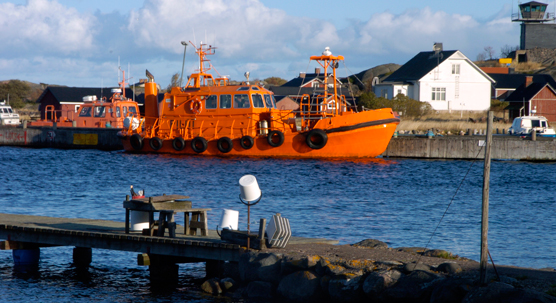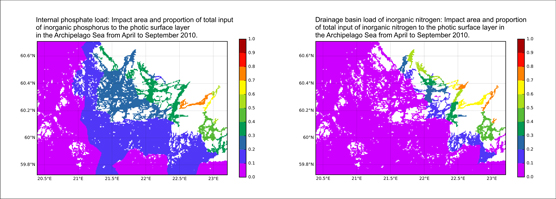Press release 2019-01-16 at 9:00

The impact of nutrient load on the quality of coastal waters can now be modelled with improved precision and realism. Developed for the Gulf of Finland, Archipelago Sea and Bothnian Sea, the model offers a new tool for assessing the environmental impact of various human activities. © Riku Lumiaro / SYKE
The impact of nutrient load on the quality of coastal waters can now be modelled with improved precision and realism. Developed for the Gulf of Finland, Archipelago Sea and Bothnian Sea, the model for total coastal load offers a new tool for monitoring water quality, planning river basin management measures and assessing the environmental impact of various human activities, such as fish farming. The new model is included in Finland’s new Strategy for the Baltic Sea.
Led by the Finnish Environment Institute (SYKE) and funded by the Ministry of the Environment, the project has developed a coastal nutrient load model system for calculating the impact of various nutrient sources in the Gulf of Finland, Archipelago Sea and Bothnian Sea. Current ecosystem models for the Baltic Sea fail to take into account coastal zones, which are crucial for both humans and the environment. The new model allows the continuum formed by inland waters, coastal zones and open sea to be analysed and assessed in a coherent manner.
The calculation of total nutrient load takes into account load from the catchment and internal nutrient load from seafloor sediments, point-source pollution, airborne pollution and background load caused by water exchange with the open sea. The new FICOS model system (Finnish Coastal Nutrient Load Model) can be used in monitoring water quality, planning measures for river basin and marine resources management, and assessing the impact of various human activities to water bodies. The model is also suitable as a tool in the permitting of, for example, fish farming.
“In terms of research, the biggest challenge we faced was the implementation of three-dimensional flow model to the topographically complex coastal areas. Our model couples adequately realistic hydrodynamic and biogeochemical models of the coast with SYKE’s operative drainage basin model VEMALA, making it the first of its kind in the Baltic Sea region,” says head of the project, Senior Researcher Risto Lignell from SYKE.
Improved understanding of the significance of internal load
The newly developed model system can be used to realistically simulate the annual development of algal biomass (nitrogen-fixing blue-green algae and other algae), chlorophyll a and phosphorus and nitrogen concentrations (inorganic and total), and the impact of changes in nutrient load on these variables (Figure 1). The model can simulate the transport and dilution of nutrient emissions in various parts of the Archipelago Sea up to a spatial resolution of 500 m.
The FICOS model was used to assess the impact areas and relative significance of different sources of nutrient load within the Archipelago Sea. The input of inorganic nitrogen from the drainage basin and inorganic phosphorus from the seafloor sediment were found to be the most significant sources of load to impact surface water quality in the inner and middle archipelago. They accounted for 30–70% of respective total inorganic nutrient input to the surface layer during the growth period from April to September (Figure 2).
According to the modelling results, approximately half of the internal phosphorus load from the seafloor ends up in the surface layer. In the outer archipelago, background load from water exchange with the open sea is by far the most significant input of nutrients. However, most of this load is compensated with a short delay as the result of output by currents flowing away from the area.
Finnish nutrient load mainly affects domestic coastal waters
“The FICOS assessments demonstrate that the effects of nutrient load caused by Finland are mainly concentrated in our own coastal areas. In practice, this means that efforts to reduce nutrient load in Finland will have direct local impact. Furthermore, the results show that if for instance special measures, such as selective fishing or load reduction from other sources, are used to compensate the nutrient load caused by fish farming these measures should be targeted at the very same coastal areas,” says Lignell.
The project presented forecasts for the Archipelago Sea on how various management measures will affect water quality over the long run in 30–100 years. If the Baltic Sea Action Plan (BSAP) could be implemented for the entire Baltic Sea (BALTSEM model estimate by the Baltic Nest Institute), and nutrient load from farms in the Archipelago Sea drainage basin could be reduced to the lowest level achievable with current technology (estimated by VEMALA model), the concentration of chlorophyll a indicating the eutrophication of the water column would, depending on the water area, be reduced by 10–30% in spring and autumn and 0–20% in summer by 2050, in comparison with continuing current practices. (Figure 3).
The relatively small difference between the impact of current and stricter water protection measures over timeframe in question is partly due to the impacts of climate change: increased precipitation in spring and autumn increases the transport of nutrients and reduces the effectiveness of protection measures, whereas in summer, run-off and load are low. Still, any decrease in algal biomass would result in reduced sedimentation, which in turn would improve seafloor oxygen levels, reduce internal load and decline nitrogen-fixing blue-green algal blooms of late summer. All three are key targets of Finnish coastal water protection measures and reaching them requires long-term, innovative policies.
The model for total nutrient load was commissioned and funded by the Ministry of the Environment as part of the programme for nutrient recycling. The project was carried out by a consortium led by the Finnish Environment Institute and consisting of the Finnish Meteorological Institute and Åbo Akademi. The project was implemented in close cooperation with the primary end users of the model system, i.e., the Ministry of the Environment and the Centres for Economic Development, Transport and the Environment of Southwest Finland, Uusimaa, Southeast Finland, South Ostrobothnia and North Ostrobothnia. Scientific partners in the project also included the Stockholm University Baltic Nest Institute, Stockholm KTH Royal Institute of Technology and the Universities of Bergen, Helsinki and Turku.
Figure 1: Time courses of algal biomass, chlorophyll a and nutrients in outer Archipelago Sea: model simulation (continuous line) vs. observations (points)

Results calculated with the FICOS model closely match with observations. The model is able to simulate the annual patterns in variable development (chlorophyll a as well as inorganic and total nutrients) and succession of algal biomass (nitrogen-fixing blue-green algae and others). As the model has not been specifically adjusted for the dataset in question, the results are promising, particularly in the case of biological responses. The observations were measured in various parts of the bodies of water, which increases their natural variation.n. © Finnsih Enviroment Institute SYKE
Figure 2: Relative significance of different sources of nutrient load within the Archipelago Sea

The FICOS model can be used to assess the impact areas and relative significance of different nutrient sources for surface water quality. In the inner archipelago, the most significant sources are the input of inorganic nitrogen from the drainage basin and inorganic phosphorus from the seafloor sediment. Background load from water exchange with the open sea dominates inputs to the outer archipelago.. © Finnish Environment Institute SYKE
Figure 3. Baltic Sea Action Plan (BSAP) and the impact of minimisation of local agricultural load vs. continuation of current practices: Difference (%) in chlorophyll a concentration in the Archipelago Sea by 2050

If nutrient load from farms in the drainage basin of the Archipelago Sea could be reduced to the lowest level achievable with current technology, inorganic nitrogen and inorganic phosphorus loads would decrease by approx. 25% and 14% from current levels, respectively. In addition, if also the BSAP could be implemented for the entire Baltic Sea region, the concentration of chlorophyll a by 2050 would decrease by 10–30% in the spring and autumn and 0–20% in the summer, compared with continuing current practices. The impacts of climate change are already visible in these scenarios for 2050. Stricter water protection measures are partially counteracted by increased precipitation due to climate change and the resulting increase in nutrient load transported into the sea during winter, spring and autumn. © Finnish Environment Institute SYKE
For further information, please contact
Senior Researcher Risto Lignell, Finnish Environment Institute (SYKE), tel. +358 (0)40 182 3248, firstname.lastname@ymparisto.fi
Communication Expert Eija Järvinen, Finnish Environment Institute (SYKE), tel. +358 (0)40 743 9856 firstname.lastname@ymparisto.fi
Figures for media:
Figure 1 (.png)
Figure 2 (.png)
Figure 3 (.png)